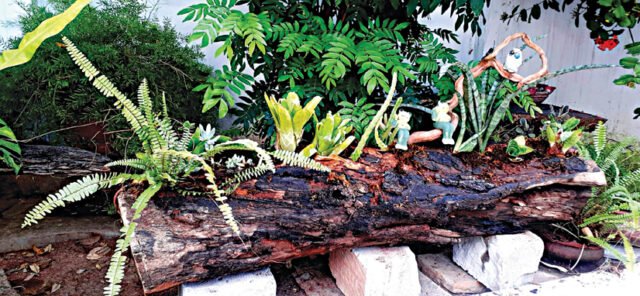Nothing can match the beauty and bliss of a sun-drenched meadow filled with a riot of colours. But you don’t need to climb mountains or cross a stream to escape into the meadows because you now have meadowscaping! Greenies break down the latest fad of meadowscaping and share some easy hacks to create a low-maintenance, lush, evocative garden just outside your doorstep.
Magical Meadows
The trend of converting a traditional lawn into a vibrant meadow, commonly known as meadowscaping, is becoming increasingly popular among urban eco-enthusiasts. Unlike conventional lawns, meadows — vast spaces filled with various herbaceous plants, such as tall grasses, flowers, and herbs — offer a more cost-effective maintenance solution, require less water and energy, and play a crucial role in capturing carbon dioxide. Importantly, they enhance variety in nature and often draw in pollinators, which are essential for healthy ecosystems.
Nature & Sustainability
Four years ago, when there was a water shortage, Deepa Shailendra, a Kapra Lake guardian and freelance blogger realised that having a traditional lawn was a criminal waste of water. She removed the carpet grass and substituted it with buffalo grass, which is hardier and consumes less water. She also used a combination of ferns, ficus benjaminas, a variety of colourful leafy shrubs, and indigenous flowering plants that were staged together in bunches for effect, along with Japanese grass. Deepa also planted Singapore cherry trees because the sparrows enjoy the fruit. “It’s another tale that instead of attracting sparrows, I got a whole bunch of fruit bats, crows and squirrels, but it was nice to see that the lawn was being taken over by small Singapore cherry trees that were growing with every monsoon,” she says. The most critical part was that because of the natural sloping of her plot, all rainwater was flowing towards the lawn and got absorbed into the soil.
Go Native, Save Water
Meadowscaping is a movement that focuses on cultivating biodiversity and providing habitat for birds, butterflies, bees, and other insects. Kalpana Ramesh, a Go Green Water Conservationist and Founder of The Rainwater Project opines that people should focus on native plants and rainfall retention. “Feature varieties that support the local ecosystem, like wildflowers, native ornamental grasses, pollinator-friendly perennials, and grass alternatives,” says Kalpana. The ground cover in all the green areas of Kalpana’s house consists of a variety of useful trees and plants, such as drumstick, jackfruit, guava, chikoo, ramphal, hibiscus, bilva tree, champakali, turmeric, tulsi, and various types of basil. Bougainville, jasmine, chamanthi, etc., can be used as layered plantations. Arrange them in interesting bunches and colourcode them. “They look beautiful and are useful. We use flowers and fruits for pooja rituals and also grow vegetables daily,” she says.
Max Greenery, Min Waste
Dr DV Ramakrishna, a Robotic and MIS Gastro Surgeon, KIMS Hospital, who is also an avid nature lover was clear that at Tranquilla, his idea was to live green and live bright. Dr Ramakrishna chose the plantation accordingly. The patio is adorned with overhanging indigenous creepers. “I have carefully paired lemongrass and mosquito-repellent plants with orchids and flowering plants,” he says. The blooming lotus surrounds the stone Buddha statue, which serves as the central attraction of my compact zen garden. The idea was to maximise greenery and minimise water consumption.
A New Lease of Life
Meadows and green spaces are a natural retreat for many people in the world. Rekha Bayanker (74), a self-taught garden enthusiast, enjoys recycling old things and giving a new lease of life to dead materials. Rekha, who has been living in Sainikpuri for the past 40 years has experimented with various styles of garden features. Her garden creations are very intriguing and challenging. “I enjoy giving life to dead materials, such as dead wood and rocks, and have created gardens out of them,” says Rekha enthusiastically. By sharing and showcasing her creations, she hopes to inspire other garden enthusiasts to use these ideas and create their own unique and imaginative garden features. Her fitness and gardening mantra is cycle, reuse old materials, and give them a new life as a customised garden feature.
Greenzone Knowledge
Principal Interior Designer, SC Design,
Sona Chatwani shares a few helpful tips on starting this eco-friendly lawn alternative. For Hyderabad’s semi-arid climate and Deccan plateau ecology, here are some native and well-adapted plants ideal for meadowscaping:
· The native grass, Centchrus setigerus, also known as birdwood grass, is drought-tolerant
and a good ground cover.
· Chrysopogon fulvus supports soil binding and low water needs.
· Vetiveria zizanioides (vetiver)—deep roots, great for stabilising soil.
A Green Haven
Nature always has all the right roots. By transforming their yard into a flourishing meadow of local plants, Srilekha Patangay, a nature lover and green buff not only attracted butterflies and bees, but also played a role in mitigating her family’s carbon footprint. “My house is at an elevation, and my garden slopes downward. To take advantage of this, I have small lotus ponds at the bottom of the garden to catch the rainfall runoff,” she explains. The rest of the lawn and plants evolved organically around it. “It is my haven of peace and serenity.” Srilekha adds.







